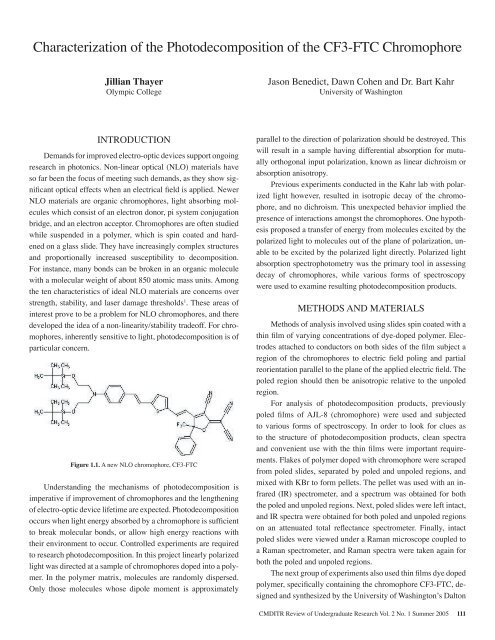Student Project Abstracts 2005 - Pluto - University of Washington
Student Project Abstracts 2005 - Pluto - University of Washington
Student Project Abstracts 2005 - Pluto - University of Washington
You also want an ePaper? Increase the reach of your titles
YUMPU automatically turns print PDFs into web optimized ePapers that Google loves.
Characterization <strong>of</strong> the Photodecomposition <strong>of</strong> the CF3-FTC ChromophoreJillian ThayerOlympic CollegeJason Benedict, Dawn Cohen and Dr. Bart Kahr<strong>University</strong> <strong>of</strong> <strong>Washington</strong>INTRODUCTIONDemands for improved electro-optic devices support ongoingresearch in photonics. Non-linear optical (NLO) materials haveso far been the focus <strong>of</strong> meeting such demands, as they show significantoptical effects when an electrical field is applied. NewerNLO materials are organic chromophores, light absorbing moleculeswhich consist <strong>of</strong> an electron donor, pi system conjugationbridge, and an electron acceptor. Chromophores are <strong>of</strong>ten studiedwhile suspended in a polymer, which is spin coated and hardenedon a glass slide. They have increasingly complex structuresand proportionally increased susceptibility to decomposition.For instance, many bonds can be broken in an organic moleculewith a molecular weight <strong>of</strong> about 850 atomic mass units. Amongthe ten characteristics <strong>of</strong> ideal NLO materials are concerns overstrength, stability, and laser damage thresholds 1 . These areas <strong>of</strong>interest prove to be a problem for NLO chromophores, and theredeveloped the idea <strong>of</strong> a non-linearity/stability trade<strong>of</strong>f. For chromophores,inherently sensitive to light, photodecomposition is <strong>of</strong>particular concern.Figure 1.1. A new NLO chromophore, CF3-FTCUnderstanding the mechanisms <strong>of</strong> photodecomposition isimperative if improvement <strong>of</strong> chromophores and the lengthening<strong>of</strong> electro-optic device lifetime are expected. Photodecompositionoccurs when light energy absorbed by a chromophore is sufficientto break molecular bonds, or allow high energy reactions withtheir environment to occur. Controlled experiments are requiredto research photodecomposition. In this project linearly polarizedlight was directed at a sample <strong>of</strong> chromophores doped into a polymer.In the polymer matrix, molecules are randomly dispersed.Only those molecules whose dipole moment is approximatelyparallel to the direction <strong>of</strong> polarization should be destroyed. Thiswill result in a sample having differential absorption for mutuallyorthogonal input polarization, known as linear dichroism orabsorption anisotropy.Previous experiments conducted in the Kahr lab with polarizedlight however, resulted in isotropic decay <strong>of</strong> the chromophore,and no dichroism. This unexpected behavior implied thepresence <strong>of</strong> interactions amongst the chromophores. One hypothesisproposed a transfer <strong>of</strong> energy from molecules excited by thepolarized light to molecules out <strong>of</strong> the plane <strong>of</strong> polarization, unableto be excited by the polarized light directly. Polarized lightabsorption spectrophotometry was the primary tool in assessingdecay <strong>of</strong> chromophores, while various forms <strong>of</strong> spectroscopywere used to examine resulting photodecomposition products.METHODS AND MATERIALSMethods <strong>of</strong> analysis involved using slides spin coated with athin film <strong>of</strong> varying concentrations <strong>of</strong> dye-doped polymer. Electrodesattached to conductors on both sides <strong>of</strong> the film subject aregion <strong>of</strong> the chromophores to electric field poling and partialreorientation parallel to the plane <strong>of</strong> the applied electric field. Thepoled region should then be anisotropic relative to the unpoledregion.For analysis <strong>of</strong> photodecomposition products, previouslypoled films <strong>of</strong> AJL-8 (chromophore) were used and subjectedto various forms <strong>of</strong> spectroscopy. In order to look for clues asto the structure <strong>of</strong> photodecomposition products, clean spectraand convenient use with the thin films were important requirements.Flakes <strong>of</strong> polymer doped with chromophore were scrapedfrom poled slides, separated by poled and unpoled regions, andmixed with KBr to form pellets. The pellet was used with an infrared(IR) spectrometer, and a spectrum was obtained for boththe poled and unpoled regions. Next, poled slides were left intact,and IR spectra were obtained for both poled and unpoled regionson an attenuated total reflectance spectrometer. Finally, intactpoled slides were viewed under a Raman microscope coupled toa Raman spectrometer, and Raman spectra were taken again forboth the poled and unpoled regions.The next group <strong>of</strong> experiments also used thin films dye dopedpolymer, specifically containing the chromophore CF3-FTC, designedand synthesized by the <strong>University</strong> <strong>of</strong> <strong>Washington</strong>’s DaltonCMDITR Review <strong>of</strong> Undergraduate Research Vol. 2 No. 1 Summer <strong>2005</strong> 111




